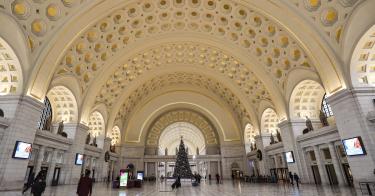The Federal Railroad Administration has released a massive draft environmental impact statement for a planned $8.8 billion expansion of Washington’s Union Station. The project is a testament to how little regard governments have for common sense and hard-earned taxpayer dollars.
Union Station, which is just north of Capitol Hill, opened in 1907. It serves as a hub for Amtrak, intercity buses, and regional public transit systems.
In 2012, Amtrak created a Union Station Master Plan that envisioned a staggering expansion far beyond what reality would justify. Since then, the case for expansion has virtually evaporated.
The Washington Metro Area Transit Authority has encountered a series of problems with its rail system. Fires and protracted service disruptions led to a significant ridership decline through 2019.
Then COVID-19 hit, and things really went south. Even though most modes of transportation have recovered from pandemic-era lows, transit usage in Washington remains anemic. Ridership in 2022 was less than 60% of 2019 levels.
The same holds true for the Virginia Railway Express commuter line, whose March 2023 ridership was a mere 34% of its February 2020 level.
>>> Here’s the Problem With Biden Wanting to Ban Cars That Don’t Run on Batteries
There are several reasons why so many Capitol region residents have shunned its heavily subsidized trains and buses.
Fewer workers commute to the city, especially federal bureaucrats. Crime in the system has increased dramatically. A derailment in 2021 led to massive disruptions when the agency determined that there was a systemic problem with recently purchased rail cars.
The result of those combined trends is fewer people using transit in the area. There is no guarantee that ridership will ever recover to 2019 levels, let alone 2011 levels.
In turn, since most of Union Station’s pre-pandemic use was for transit, the station has suffered an enormous decline in foot traffic.
Shops in the station have closed en masse; criminals are emboldened, and there is a persistent struggle to manage the area’s homeless population. Union Station is now a symbol of decline.
Unlike in 2012, there are now widespread concerns about the station’s long-term viability. In this context, the government’s commitment to the expansion plan, at taxpayer expense, ought to be a scandal.
Key details of the plan, however, would be cause for concern even if the station were safe and vibrant. For example, the expansion plan calls for a 77% reduction in parking spaces. This is the result of complaints from city officials and activists who actively want to discourage people from driving.
A dramatic reduction in parking would not only eat into parking revenue—which has historically been important for Union Station to keep the lights on—but also make it harder for people from the surrounding area to drive in and use the important transportation hub. (To much of the progressive left, a “hub” should be available only for their preferred modes of transportation, ignoring how the vast majority of Americans live and work.)
If it goes forward, the expansion project would produce an enormous white elephant. And there is no reason to believe that if it were completed, the project would somehow miraculously avoid the cost overruns and delays endemic to government megaprojects.
That this illogical expansion is still under consideration is just one way in which this situation typifies governmental dysfunction. Another is that work on the environmental impact statement, which needs to be approved before the expansion can proceed, began in 2015 and ran three years behind schedule. This is sadly not unusual due to poorly drafted Nixon-era legislation.
>>> Planes Fly on Modern IT, Not Green Dreams
While not settled, signs point to Uncle Sam’s committing the taxes collected from hardworking Americans to fund the $8.8 billion boondoggle.
This proposal comes at a time when the federal government has amassed debt levels not seen since World War II. There is a raging debate over how to address long-term imbalances, and families have lost thousands of dollars in purchasing power due to rampant inflation.
Going $8.8 billion deeper in debt for an unnecessary Union Station expansion would make those problems even worse.
Enough is enough. Before the federal government throws Americans’ good money after bad, officials at the federal and regional levels should pull the handbrake and reexamine plans in light of 2023 realities.
Congress should step in and use the appropriations process to bar the Federal Railroad Administration from continuing work on the plan until it can account for changes in how the public uses Union Station and provide down-to-earth ridership projections.
It’s not too late to stop this bad idea in its tracks.
This piece originally appeared in The Washington Times



